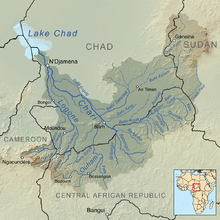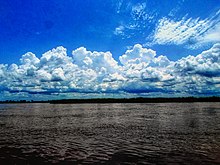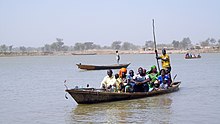Logone River
This article needs additional citations for verification. (December 2009) |
| Logone River | |
|---|---|
 The Logone-Birni, from the book The earth and its inhabitants, Africa 1892 | |
 Map showing the Logone River within the Chari River drainage basin | |
| Location | |
| Countries | |
| City | Kousséri |
| Physical characteristics | |
| Source | |
| • location | Central African Republic |
| Mouth | |
• location | Chari River at N'Djaména, Chad |
• coordinates | 12°6′22″N 15°2′7″E / 12.10611°N 15.03528°E |
• elevation | 364 m (1,194 ft) |
| Length | 1,000 km (620 mi) |
| Basin size | 78,000 km2 (30,000 sq mi) |
| Discharge | |
| • average | 492 m3/s (17,400 cu ft/s) |
| Basin features | |
| Protection status | |
| Official name | Plaines d'inondation du Logone et les dépressions Toupouri |
| Designated | 14 November 2005 |
| Reference no. | 1560[1] |
The Logon or Logone River is a major tributary of the Chari River. The Logone's sources are located in the western Central African Republic, northern Cameroon, and southern Chad. It has two major tributaries: the Pendé River (Eastern Logone) in the prefecture Ouham-Pendé in the Central African Republic and the Mbéré River (Western Logone) at the east of Cameroon.[2] Many swamps and wetlands surround the river.
Settlements on the river include Kousseri, Cameroon's northernmost city, and Chad's capital city, N'Djaména, which is located at the spot where the Logone empties into the Chari River.
The Logone forms part of the international border between Chad and Cameroon.
Hydrometry
The flow of the river has been observed over 38 years (1951–84) in Bongor a town in Chad downstream of the union with the Pendé about 450 km (280 mi) above the mouth into the Chari.[3] The Bongor observed average annual flow during this period was 492 m3/s (17,400 cu ft/s) fed by an area of about 73.7 km2 (28.5 sq mi) approximately 94.5% of the total catchment area of the River. Due to the strong evaporation, the amount of water flowing into the estuary decreases. In N'Djamena, the flow reduces to 400 m3/s (14,000 cu ft/s).
The average monthly flow of the river Logone at hydrological station of Bongor (in m3 / s )
(Calculated using the data for a period of 38 years, 1948–86)

Population
In the eastern lower Logone valley formed out of the Kotoko population several historic sultanates (Kousseri, Logone-Birni, Makari-Goulfey and others) which were vassals of the Bornu or Baguirmi inside the borders of modern-day Cameroon.
History
In Chad, the administrative regions Logone Oriental and Logone Occidental named after the river. Ober-Logone was an administrative district of the German colony of Cameroon.


September 2013 dam failure and flood
On the night of September 17 to September 18, 2013, heavy rains caused a rupture of the dam along the Logone River at the town of Dougui, Kai Kai District in the Far North Region of Cameroon. This caused initial evacuations of people to the banks of the dam. On September 27, a second rupture in the dam 4 km (2.5 mi) from the first rupture started flooding the area and nearly 9,000 people were displaced.[4]
-
Logone River
-
Mototaxi
-
Canoe
-
Stone block on the banks of the Zébé Marao Cameroon
-
Piroge towards the shore opposite Zébé Marao Cameroon
-
Fishing in Zébé Marao
References
- ^ "Plaines d'inondation du Logone et les dépressions Toupouri". Ramsar Sites Information Service. Retrieved 25 April 2018.
- ^ "Logone River | river, Africa". Encyclopedia Britannica. Retrieved 2017-06-06.
- ^ GRDC - Chari Basin : Der Logone in Bongor
- ^ "Cameroon: Floods - Oct 2013". ReliefWeb. Retrieved 2014-06-10.






